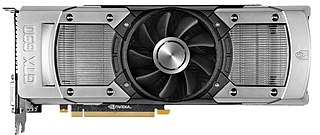
Nvidia Corporation, commonly known as Nvidia, is an American multinational technology company incorporated in Delaware and based in Santa Clara, California. It is a software and fabless company which designs graphics processing units (GPUs), application programming interface (APIs) for data science and high-performance computing as well as system on a chip units (SoCs) for the mobile computing and automotive market. Nvidia is a global leader in artificial intelligence hardware and software. Its professional line of GPUs are used in workstations for applications in such fields as architecture, engineering and construction, media and entertainment, automotive, scientific research, and manufacturing design.

GeForce is a brand of graphics processing units (GPUs) designed by Nvidia. As of the GeForce 30 series, there have been seventeen iterations of the design. The first GeForce products were discrete GPUs designed for add-on graphics boards, intended for the high-margin PC gaming market, and later diversification of the product line covered all tiers of the PC graphics market, ranging from cost-sensitive GPUs integrated on motherboards, to mainstream add-in retail boards. Most recently, GeForce technology has been introduced into Nvidia's line of embedded application processors, designed for electronic handhelds and mobile handsets.

Alienware is an American computer hardware subsidiary of Dell. Their product range is dedicated to gaming computers which can be identified by their alien-themed designs. Alienware was founded in 1996 by Nelson Gonzalez and Alex Aguila, and is currently led by Vivian Lien. The development of the company is also associated with Frank Azor, Arthur Lewis, Joe Balerdi, and Michael S. Dell. The company's corporate headquarters is located in The Hammocks, Miami, Florida.

Scalable Link Interface (SLI) is a brand name for a deprecated multi-GPU technology developed by Nvidia for linking two or more video cards together to produce a single output. SLI is a parallel processing algorithm for computer graphics, meant to increase the available processing power.
The GeForce 8 series is the eighth generation of Nvidia's GeForce line of graphics processing units. The third major GPU architecture developed by Nvidia, Tesla represents the company's first unified shader architecture.

Graphics Double Data Rate 5 Synchronous Dynamic Random-Access Memory is a type of synchronous graphics random-access memory (SGRAM) with a high bandwidth interface designed for use in graphics cards, game consoles, and high-performance computing. It is a type of GDDR SDRAM.
The GeForce 200 series is a series of Tesla-based GeForce graphics processing units developed by Nvidia.
Serving as the introduction of Fermi, the GeForce 400 series is a series of graphics processing units developed by Nvidia. Its release was originally slated in November 2009; however, after delays, it was released on March 26, 2010 with availability following in April 2010.
A refresh of the Fermi based GeForce 400 series, the GeForce 500 series is a series of graphics processing units developed by Nvidia, first released on November 9, 2010 with the GeForce GTX 580.

Serving as the introduction of Kepler architecture, the GeForce 600 series is a series of graphics processing units developed by Nvidia, first released in 2012.

The GeForce 700 series is a series of graphics processing units developed by Nvidia. While mainly a refresh of the Kepler microarchitecture, some cards use Fermi (GF) and later cards use Maxwell (GM). GeForce 700 series cards were first released in 2013, starting with the release of the GeForce GTX Titan on February 19, 2013, followed by the GeForce GTX 780 on May 23, 2013. The first mobile GeForce 700 series chips were released in April 2013.
In computer architecture, 512-bit integers, memory addresses, or other data units are those that are 512 bits wide. Also, 512-bit central processing unit (CPU) and arithmetic logic unit (ALU) architectures are those that are based on registers, address buses, or data buses of that size. There are currently no mainstream general-purpose processors built to operate on 512-bit integers or addresses, though a number of processors do operate on 512-bit data.
The GeForce 800M series is a family of graphics processing units by Nvidia for laptop PCs. It consists of rebrands of mobile versions of the GeForce 700 series and some newer chips that are lower end compared to the rebrands.

The GeForce 900 series is a family of graphics processing units developed by Nvidia, succeeding the GeForce 700 series and serving as the high-end introduction to the Maxwell microarchitecture, named after James Clerk Maxwell. They are produced with TSMC's 28 nm process.

The GeForce 10 series is a series of graphics processing units developed by Nvidia, initially based on the Pascal microarchitecture announced in March 2014. This design series succeeded the GeForce 900 series, and is succeeded by the GeForce 16 series and GeForce 20 series using the Turing microarchitecture.
Maxwell is the codename for a GPU microarchitecture developed by Nvidia as the successor to the Kepler microarchitecture. The Maxwell architecture was introduced in later models of the GeForce 700 series and is also used in the GeForce 800M series, GeForce 900 series, and Quadro Mxxx series, as well as some Jetson products, all manufactured with TSMC's 28 nm process.

Pascal is the codename for a GPU microarchitecture developed by Nvidia, as the successor to the Maxwell architecture. The architecture was first introduced in April 2016 with the release of the Tesla P100 (GP100) on April 5, 2016, and is primarily used in the GeForce 10 series, starting with the GeForce GTX 1080 and GTX 1070, which were released on May 17, 2016 and June 10, 2016 respectively. Pascal was manufactured using TSMC's 16 nm FinFET process, and later Samsung's 14 nm FinFET process.

Nvidia GeForce RTX is a high-end professional visual computing platform created by Nvidia, primarily used for designing complex large-scale models in architecture and product design, scientific visualization, energy exploration, games, and film and video production. Nvidia RTX enables real-time ray tracing. Historically, ray tracing had been reserved to non-real time applications, with video games having to rely on direct lighting and precalculated indirect contribution for their rendering. RTX facilitates a new development in computer graphics of generating interactive images that react to lighting, shadows and reflections. RTX runs on Nvidia Volta-, Turing- and Ampere-based GPUs, specifically utilizing the Tensor cores on the architectures for ray-tracing acceleration.
Turing is the codename for a graphics processing unit (GPU) microarchitecture developed by Nvidia. It is named after the prominent mathematician and computer scientist Alan Turing. The architecture was first introduced in August 2018 at SIGGRAPH 2018 in the workstation-oriented Quadro RTX cards, and one week later at Gamescom in consumer GeForce RTX 20 series graphics cards. Building on the preliminary work of its HPC-exclusive predecessor, the Turing architecture introduces the first consumer products capable of real-time ray tracing, a longstanding goal of the computer graphics industry. Key elements include dedicated artificial intelligence processors and dedicated ray tracing processors. Turing leverages DXR, OptiX, and Vulkan for access to ray-tracing. In February 2019, Nvidia released the GeForce 16 series of GPUs, which utilizes the new Turing design but lacks the RT and Tensor cores.










